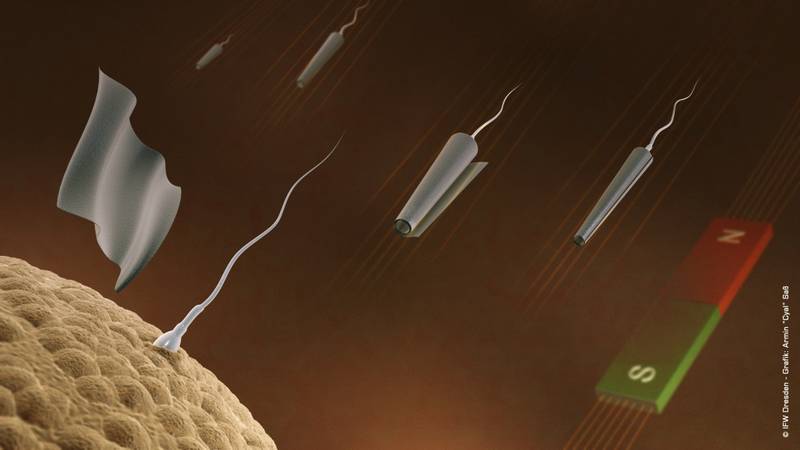Tiny swimming ‘biobots’ propelled by heart cells or magnetic fields
January 21, 2014
[+]
University of Illinois engineers have developed tiny “bio-bot” hybrid
machines that swim like sperm, the first synthetic structures that can
traverse the viscous fluids of biological environments on their own,
according to the engineers.
Synthetic biobots (b) powered by contractile cells are modeled on spermatozoa (a) (credit: Brian J. Williams et al./Nature Communications)
The devices are modeled after single-celled creatures with long tails called flagella — for example, sperm. The researchers begin by creating the body of the bio-bot from a flexible polymer. Then they culture heart cells near the junction of the head and the tail. The cells self-align and synchronize to beat together, sending a wave down the tail that propels the bio-bot forward.
Led by Taher Saif, the Gutgsell Professor of mechanical science and engineering, the team published its work in the journal Nature Communications.
This self-organization is a remarkable emergent phenomenon, Saif said, and how the cells communicate with each other on the flexible polymer tail is yet to be fully understood. But the cells must beat together, in the right direction, for the tail to move.
“It’s the minimal amount of engineering — just a head and a wire,” Saif said. “Then the cells come in, interact with the structure, and make it functional.”
The biobots can swim at 81 microns (millionths of a meter) per second. The team also built two-tailed bots, which they found can swim even faster. The multiple tails design also opens up the possibility of navigation. The researchers envision future bots that could sense chemicals or light and navigate toward a target for medical or environmental applications.
“The long-term vision is simple,” said Saif, who is also part of the Beckman Institute for Advanced Science and Technology at the U. of I. “Could we make elementary structures and seed them with stem cells that would differentiate into smart structures to deliver drugs, perform minimally invasive surgery or target cancer?”
The swimming bio-bot project is part of a larger National Science Foundation-supported Science and Technology Center on Emergent Behaviors in Integrated Cellular Systems, which also produced the walking bio-bots developed at Illinois in 2012.
“The most intriguing aspect of this work is that it demonstrates the capability to use computational modeling in conjunction with biological design to optimize performance, or design entirely different types of swimming bio-bots,” said center director Roger Kamm, a professor of biological and mechanical engineering at MIT. “This opens the field up to a tremendous diversity of possibilities. Truly an exciting advance.” Commercialization will take several years, Saif told KurzweilAI.
What’s remarkable about the design is that a power source and electronics are not required. Swimming microrobots previously reported by KurzweilAI include:
- Are you ready for smart ingestible pills that monitor your health and replace passwords?
- How micron-scale swimming robots could deliver drugs and carry cargo
- The ‘living’ micro-robot that could detect diseases in humans
- Bionic microrobot walks on water — perfect spybot, say Chinese scientists
- Pathogen research inspires microrobotics designs
- One signal controls microrobot swarms
- Microbots made to twist and turn as they swim

Sperm
with a magnetic coating are controlled by a magnetic field. Just before
the sperm reaches the egg, the magnetic coating is ejected. (Credit:
Leibniz Institute for Solid State and Materials Research Dresden)
According to IFW Dresden prof. Oliver Schmidt, the design could also assist in artificial insemination, by guiding the sperm to fertilize eggs in a living organism. “Previous experiments were performed with bovine sperm, but the method is in principle applicable to all mammalian sperm,” said Schmidt, who heads the Institute for Integrative Nanosciences at the IFW Dresden and holds a chair at the Technical University of Chemnitz.
Abstract of Nature Communications paper
Many microorganisms, including spermatozoa and forms of bacteria, oscillate or twist a hair-like flagella to swim. At this small scale, where locomotion is challenged by large viscous drag, organisms must generate time-irreversible deformations of their flagella to produce thrust. To date, there is no demonstration of a self propelled, synthetic flagellar swimmer operating at low Reynolds number. Here we report a microscale, biohybrid swimmer enabled by a unique fabrication process and a supporting slender-body hydrodynamics model. The swimmer consists of a polydimethylsiloxane filament with a short, rigid head and a long, slender tail on which cardiomyocytes are selectively cultured. The cardiomyocytes contract and deform the filament to propel the swimmer at 5–10 μm s−1, consistent with model predictions. We then demonstrate a two-tailed swimmer swimming at 81 μm s−1. This small-scale, elementary biohybrid swimmer can serve as a platform for more complex biological machines.
Abstract of Advanced Materials paper
A fascinating approach to the development of a hybrid micro-bio-robot is presented by Samuel Sanchez, Oliver G. Schmidt and Veronika Magdanz on page 6581. Rolled-up microtubes are used to capture single sperm cells and remotely control them to a desired location. These microbio-robots are useful for the controlled guidance of sperm cells, which is a promising feature towards the development of new assisted-fertilization techniques.
(¯`*• Global Source and/or more resources at http://goo.gl/zvSV7 │ www.Future-Observatory.blogspot.com and on LinkeIn Group's "Becoming Aware of the Futures" at http://goo.gl/8qKBbK │ @SciCzar │ Point of Contact: www.linkedin.com/in/AndresAgostini
 Washington
Washington